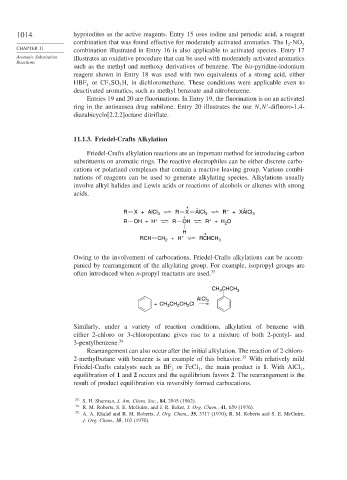Page 1038 - Advanced Organic Chemistry Part B - Reactions & Synthesis
P. 1038
1014 hypoiodites as the active reagents. Entry 15 uses iodine and periodic acid, a reagent
combination that was found effective for moderately activated aromatics. The I -NO
2 2
CHAPTER 11
combination illustrated in Entry 16 is also applicable to activated species. Entry 17
Aromatic Substitution illustrates an oxidative procedure that can be used with moderately activated aromatics
Reactions
such as the methyl and methoxy derivatives of benzene. The bis-pyridine-iodonium
reagent shown in Entry 18 was used with two equivalents of a strong acid, either
HBF or CF SO H, in dichloromethane. These conditions were applicable even to
3
3
4
deactivated aromatics, such as methyl benzoate and nitrobenzene.
Entries 19 and 20 are fluorinations. In Entry 19, the fluorination is on an activated
ring in the antinausea drug nabilone. Entry 20 illustrates the use N,N -difluoro-1,4-
diazabicyclo[2.2.2]octane ditriflate.
11.1.3. Friedel-Crafts Alkylation
Friedel-Crafts alkylation reactions are an important method for introducing carbon
substituents on aromatic rings. The reactive electrophiles can be either discrete carbo-
cations or polarized complexes that contain a reactive leaving group. Various combi-
nations of reagents can be used to generate alkylating species. Alkylations usually
involve alkyl halides and Lewis acids or reactions of alcohols or alkenes with strong
acids.
+ – –
R X + AlCl 3 R X AlCl 3 R + + XAlCl 3
+
R OH +H + R OH R + +H O
2
H +
RCH CH 2 +H + RCHCH 3
Owing to the involvement of carbocations, Friedel-Crafts alkylations can be accom-
panied by rearrangement of the alkylating group. For example, isopropyl groups are
often introduced when n-propyl reactants are used. 33
CH CHCH 3
3
AlCl 3
+CH CH CH Cl
2
3
2
Similarly, under a variety of reaction conditions, alkylation of benzene with
either 2-chloro or 3-chloropentane gives rise to a mixture of both 2-pentyl- and
3-pentylbenzene. 34
Rearrangement can also occur after the initial alkylation. The reaction of 2-chloro-
2-methylbutane with benzene is an example of this behavior. 35 With relatively mild
Friedel-Crafts catalysts such as BF or FeCl , the main product is 1. With AlCl ,
3 3 3
equilibration of 1 and 2 occurs and the equilibrium favors 2. The rearrangement is the
result of product equilibration via reversibly formed carbocations.
33 S. H. Sharman, J. Am. Chem. Soc., 84, 2945 (1962).
34 R. M. Roberts, S. E. McGuire, and J. R. Baker, J. Org. Chem., 41, 659 (1976).
35
A. A. Khalaf and R. M. Roberts, J. Org. Chem., 35, 3717 (1970); R. M. Roberts and S. E. McGuire,
J. Org. Chem., 35, 102 (1970).

